The work of the Bohemian artist Wenceslaus Hollar (1607–77), whose career coincided with a turbulent period of European history, inspired the reverse design created for the London coin in the City Views series. Born in Prague, Hollar’s Protestant family was left ruined after the plundering of the city in 1620 during the Thirty Years’ War. In 1627, Hollar moved to Germany and worked in several different cities, eventually abandoning his legal training to become the apprentice of Matthaus Merrian, one of the pre-eminent engravers of the time.
When the famous art collector Thomas Howard, the 21st Earl of Arundel, visited Cologne on a diplomatic mission in 1636, Hollar’s skills and work caught the nobleman’s attention, which led to an invitation to return with him to London. The Earl was an active and wealthy patron of the arts and Hollar seized the opportunity to escape from war-torn Germany. He arrived in London the following year and lodged at Arundel House – between the Strand and the River Thames – and the capital quickly became one of his favourite subjects.
A few years after Hollar arrived in London, the outbreak of the English Civil Wars halted his career and Hollar joined the fight on the royalist side. Following this, he spent several years in Antwerp (1644–52) where he continued to paint and draw. It was here he produced his 1647 masterpiece The Long View of London, from Bankside, which many consider one of the finest panoramas of London ever produced.
Made from the tower of St Mary Overy in Southwark, the preparatory sketches were understandably not without error but Hollar went to great lengths to ensure his design was as accurate as possible. Today, The Long View of London, from Bankside forms an important historical record of London as the Great Fire of 1666 destroyed much of what Hollar captured in his work. During this period, the artist also completed his Great View of Prague in 1649.
After returning to London in 1652, Hollar found work providing illustrations for books and produced another panorama of London after the Great Fire along with plates of cities as diverse as Tangiers and Edinburgh. Accomplished and prolific, he produced almost 2,800 prints, paintings and drawings covering a wide range of subjects during his career. Sadly, despite his talent and output, Hollar died in poverty and was laid to rest at St Margaret’s Church in Westminster.
Today, his work provides an extraordinary visual record of life in seventeenth-century Europe and hangs in prestigious museums and galleries all over the world, including the National Portrait Gallery and Tate Britain in London, as well as the Metropolitan Museum in New York. The ambition of his sweeping cityscapes along with their historical significance makes them fascinating subject matter for coins and his painting of London has been beautifully rendered in miniature by our Product Design team.


